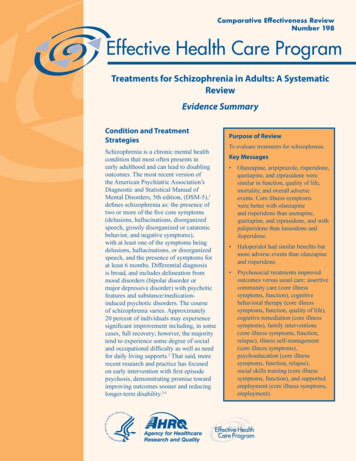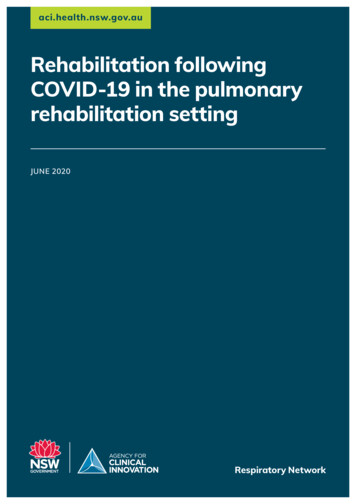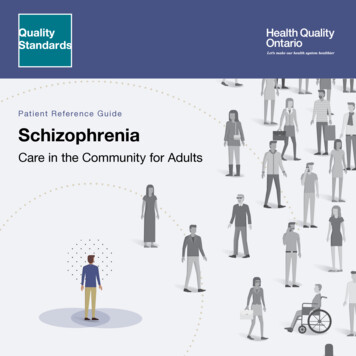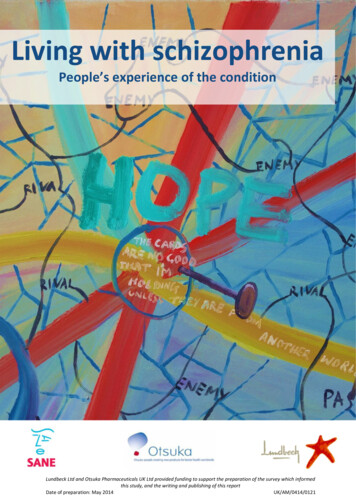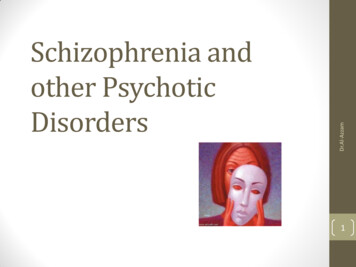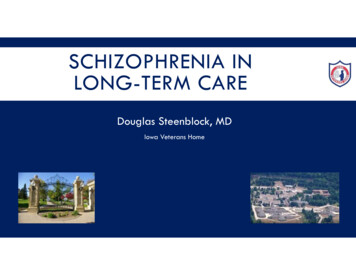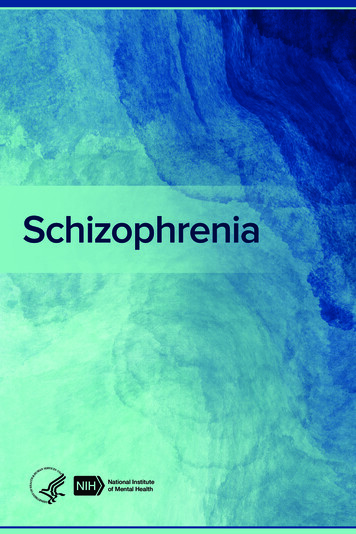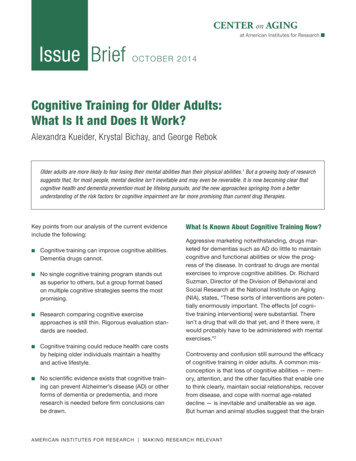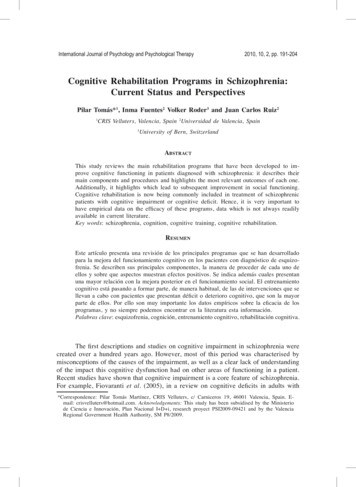
Transcription
International Journal of Psychology and Psychological Therapy2010, 10, 2, pp. 191-204Cognitive Rehabilitation Programs in Schizophrenia:Current Status and PerspectivesPilar Tomás*1, Inma Fuentes2 Volker Roder3 and Juan Carlos Ruiz21CRIS Velluters, Valencia, Spain 2Universidad de Valencia, Spain3University of Bern, SwitzerlandAbstractThis study reviews the main rehabilitation programs that have been developed to improve cognitive functioning in patients diagnosed with schizophrenia: it describes theirmain components and procedures and highlights the most relevant outcomes of each one.Additionally, it highlights which lead to subsequent improvement in social functioning.Cognitive rehabilitation is now being commonly included in treatment of schizophrenicpatients with cognitive impairment or cognitive deficit. Hence, it is very important tohave empirical data on the efficacy of these programs, data which is not always readilyavailable in current literature.Key words: schizophrenia, cognition, cognitive training, cognitive rehabilitation.ResumenEste artículo presenta una revisión de los principales programas que se han desarrolladopara la mejora del funcionamiento cognitivo en los pacientes con diagnóstico de esquizofrenia. Se describen sus principales componentes, la manera de proceder de cada uno deellos y sobre que aspectos muestran efectos positivos. Se indica además cuales presentanuna mayor relación con la mejora posterior en el funcionamiento social. El entrenamientocognitivo está pasando a formar parte, de manera habitual, de las de intervenciones que sellevan a cabo con pacientes que presentan déficit o deterioro cognitivo, que son la mayorparte de ellos. Por ello son muy importante los datos empíricos sobre la eficacia de losprogramas, y no siempre podemos encontrar en la literatura esta información.Palabras clave: esquizofrenia, cognición, entrenamiento cognitivo, rehabilitación cognitiva.The first descriptions and studies on cognitive impairment in schizophrenia werecreated over a hundred years ago. However, most of this period was characterised bymisconceptions of the causes of the impairment, as well as a clear lack of understandingof the impact this cognitive dysfunction had on other areas of functioning in a patient.Recent studies have shown that cognitive impairment is a core feature of schizophrenia.For example, Fiovaranti et al. (2005), in a review on cognitive deficits in adults with*Correspondence: Pilar Tomás Martínez, CRIS Velluters, c/ Carniceros 19, 46001 Valencia, Spain. Email: crisvelluters@hotmail.com. Acknowledgements: This study has been subsidised by the Ministeriode Ciencia e Innovación, Plan Nacional I D i, research proyect PSI2009-09421 and by the ValenciaRegional Government Health Authority, SM P8/2009.
192TOMÁS, FUENTES, RODER Y RUIZschizophrenia, identified 1275 studies made in this field between 1990 and 2003 (seealso Heinrichs, 2005 for a comprehensive view of quantative evidence demonstrating therelevance of cognition as integral part of schizophrenia). Indicating that the deficits arenot caused by other collateral aspects of the disorder, but by the illness itself. In fact,for several authors, schizophrenia is largely an essentially neurocognitive disorder (Andreasen, Paradiso & O’Leary, 1998; Green & Nuechterlein, 1999; Elvevag & Goldberg,2000; Saykin, Shtasel, Gur, Kester, Mozley, & Stafiniak, 1994; Sharma & Harvey, 2000).Although cognitive deficits had already been described when Kraepelin referred tothe decline in mental abilities of his patients, it is only recently that professionals haveidentified and agreed on the areas affected. The implementation of various initiatives inthe United States such as the MATRICS project (Measurement and Treatment Researchto Improve Cognition in Schizophrenia) has made it clear that there is still an issueas yet to be resolved: how to improve cognition. In addition to the project’s interestin improving cognition by discovering new drugs, professionals active in this field arealso looking into how to improve psychological treatment focussed on rehabilitationor cognitive training for schizophrenia. The professionals involved in the MATRICSproject have reached consensus on the cognitive areas that are impaired in patients withschizophrenia: Attention/Vigilance; Speed of Processing; Working Memory; Verbal Learning and Memory; Visual Learning and Memory; Reasoning and Problem Solving andSocial Cognition (Kern, Green, Nuechterlein & Deng, 2004; Marder & Fenton, 2004).In the third meeting of the CNTRICS project (Cognitive Neuroscience TreatmentResearch to Improve Cognition in Schizophrenia), it was agreed (Barch, Braver, Carter,Poldrack & Robbins, 2009) that 6 areas or cognitive domains suffered impairment inschizophrenia: perception, working memory, attention, executive functions, long-termmemory and social cognition.Yet however important it may well be to agree on areas, the cognitive deficitsthat have been shown to have a consistent relationship with the evolution of the illnessin the long-term are the following: memory, executive functions and attention (Muñoz& Tirapu, 2001).In recent decades interest in these deficits has been growing rapidly, judging, forexample, by the number of empirical research papers published in recent years in journals such as Schizophrenia Bulletin, Schizophrenia Research and Psychiatry Research,aiming to discover which cognitive functions are affected, to what extent, with whichconsequences and how these relate to disease factors (symptoms, social functioning,duration, hospitalization, etc.).Similarly, in recent decades a whole host of programs has been developed toimprove cognitive functioning in schizophrenia, and cognition training has become aregular component of treatment programs for people suffering from schizophrenia (Bellack, Gold, & Buchanan, 1999; Green, Kern, Braff, & Mintz, 2000).This review aims to describe the principal intervention programs currently available in this field and to present empirical data substantiating their efficiency.Assuming that a broad and intensive activation of neural processing systems canstimulate neural resources to improve their functioning (neuroplasticity), one could expectthat intense activation of the cognitive systems damaged in patients with schizophrenia International Journal of Psychology & Psychological Therapy, 2010, 10, 2http://www. ijpsy. com
COGNITIVE REHABILITATION PROGRAMS IN SCHIZOPHRENIA193would lead to a general and lasting functional improvement. It is from this basic premisethat several cognitive training strategies have been developed (Wexler & Bell, 2005).Although researches have used different terminology to describe them, the three mostcommonly used strategies are “Cognitive Remediation”, “Cognitive Rehabilitation” and“Cognitive Training” (Twamley, Jeste, & Bellack, 2003).“Remediation” implies a curative treatment. Webster (1986) defines “rehabilitation”as to restore to a state of health or normal activity. In medical terms, “rehabilitation”implies restoring functionality to premorbid levels or to a normal or near normal condition with regard to operation, performance and execution. Brain developmental disordersassociated with schizophrenia (Green & Nuechterlein, 1999) mean that it is difficult toeasily identify premorbid levels of functioning and normal or near normal functioningmay rarely be possible. Thus, “remediation” and “rehabilitation” do not seem to be themost satisfactory terms. The term “habilitation”, meaning educating or training personswith disability to improve their ability to function in society" (Taber, 1997) may bemore appropriate. “Training” is defined as “an organised system of education, instructionor discipline” (Stedman, 1995) or “the teaching, drill or discipline by which powers ofmind or body are developed” (Webster, 1986). These reflections illustrate that the mostfitting term in this field of work could well be cognitive training.Description of cognitive training programsThese can be classified into three groups according to the approach that they useto work with patients and are termed in accordance with literature in this area: trainingprograms to enhance cognition, compensatory rehabilitation programs and trainingprograms using computers.Training programs to enhance cognitionThe aim of these interventions is to improve / increase / train / “restore” cognitivefunctioning. They focus on the elimination of damage correcting the underlying deficit,with the goal of learning how to do what was done before, more or less in the sameway as before. The training is based on laboratory tests designed to improve specificabilities in areas such as perception or memory (Green, 2009). This group includes thefollowing programs.Cognitive Remediation Therapy (CRT) developed by T. Wykes and his teambased on an original program from Delahunty and Morice (1996). Interest in CRT hasgrown considerably in the last ten years. CRT is a term describing different methodsof teaching “thinking” skills, although it has a special significance when it focuses onthose cognitive skills affecting people with schizophrenia to a larger extent such asmemory and attention (Wykes & Van der Gaag, 2001). It also has a great predictivepower relating to a patient’s ability to function in the community.CRT objectives include: increasing the capacity and efficiency of cognitivefunctions; teaching global and transferable cognitive schemata to guide response; imhttp://www. ijpsy. comInternational Journal of Psychology & Psychological Therapy, 2010, 10, 2
194TOMÁS, FUENTES, RODER Y RUIZproving metacognition; increasing motivation; generalization of skills and use of socialsupport (Wykes, Jeste, & Bellack, 2003).The program consists of three modules: Cognitive Shift Module, Memory Moduleand Planning Module. Evidence of its efficiency is variable and seems to depend on thespecific components of training that are used in each case. In Spain, CRT has been usedby Penadés et al. (2006) and yielded satisfactory results. Perhaps its greatest applicationlies in boosting the cognitive and motivational skills needed to properly acquire otherskills of greater functional relevance within the rehabilitation process of a schizophrenicpatient (De la Higuera & Sagastagoitia, 2006).The Newcastle Programs is the name given to the contribution from Australia byMorice and Delahunty (1996). These authors began their research into neurocognitiverehabilitation in 1988 and since then have examined three distinct programs.The first program they used was a modified version of Integrated PsychologicalTherapy for Schizophrenia (IPT) which they named The Modified Brenner Program.This program consists of four modules based on similar IPT ones (to be describedlater). The program was carried out with four weekly sessions of one hour over twoweeks. In parallel, family members followed a psycho educational family interventionprogram with the support of audiovisual material. Finally, family members together withthe patient participated in the IPT module for problem resolution.The second program was called The Computer-Assisted Program. It is a programbased on computer exercises that have been specially designed to practise specificneurocognitive functions. It was modified from a program known as Bracy CognitiveRehabilitation, which was originally designed for patients suffering from brain damagecaused by cranial trauma. It basically focuses on attention, perceptive and reasoningfunctions.The results obtained in both programs (the modified Brenner and the computerassisted) showed improvements in most WAIS-R tests. However, in executive functions,while there were significant improvements in the Wisconsin Card Sorting Test (WSCT)and in the Tower of London, results continued to suggest deterioration in planning capacity and cognitive flexibility. It was from this that the need arose to create a specificprogram attempting to improve executive deficits, especially planning skills and cognitiveflexibility, which they then called The frontal/executive program.This program is divided into three modules: Cognitive Flexibility Module, Working Memory Module and Planning Module. With this last program the authors foundresults that were clearly higher than the other two programs as far as frontal-executivefunctions were concerned.Cognitive Enhancement Therapy (CET) from Hogarty and Flesher (1991a, 1999b)is a therapeutic procedure combining activities aimed at improving cognitive performance in basic cognitive functions, with interventions that have been developed to boostresources in aspects related to perceptive and cognitive abilities which are critical forthe social functioning and general adjustment of people with schizophrenia (Hogarty,Flescher, Ulrich et al., 2004).CET works with the idea that the primary aim of the intervention is to achievetwo basic skills: the first, really more perceptive, which seeks to adequately assess stimuli International Journal of Psychology & Psychological Therapy, 2010, 10, 2http://www. ijpsy. com
COGNITIVE REHABILITATION PROGRAMS IN SCHIZOPHRENIA195and social contexts; the second, more cognitive in nature, refers to the embracing offlexible forms of thinking that allow the presence of multiple alternatives as informationsources (divergent thinking), the anticipation of possible consequences of the responseand the appreciation of the points of views of others. To do these exercises, alternatinguse was made of computer software such as the Orientation Remediation Module ofBen-Yishay, Piasetsky and Rattock (1987) used for patients with brain damage and thePSSCogReHab of Bracy with the IPT of Roder et al. (2007).CET is a program directed at people with stable schizophrenia and it aims to improve neurocognitive skills and social cognition. It is a useful technique that goes beyondclassical cognitive rehabilitation, tackling areas and disabilities of a wider functionalrange. Its potential is far-reaching. For example, it is beginning to be tailored to treatpatients with their first-episode psychosis (Miller & Mason, 2004), but, as the authorsthemselves point out, it is not a therapeutic format applicable to all. This is why theintervention is designed for patients with a certain intellectual level (with an IQ above80) who are psychopathologically stable (De la Higuera & Sagastagoitia, 2006).Attention Shaping is a program based on approaches to modifying behaviour,including cognition (Menditto, Baldwin, O’Neal, & Beck, 1991; Spaulding, Storms,Goodrich, & Sullivan, 1986). “Shaping” involves selective reinforcement of successiveapproximations to desired behaviour. Behaviour that is close to what is required is reinforced; inappropriate behaviour is not. At the beginning, training focuses on behavioursthat have a high probability of being displayed within the behavioural repertoire of anindividual. Once behaviour is established, criteria for reinforcement moves forwardencouraging the patient to behave closer to a final model. The new behaviour is thenreinforced selectively from then on and these steps are repeated until the desired behaviour is achieved.Behavioural shaping shares methodological procedures of other training programssuch as errorless learning. A key difference is that in shaping, training is not designedto specifically prevent errors or potential behaviour that might occur, whereas in errorlesslearning, the trainer takes active steps to prevent them.Integrated Psychological Therapy for Schizophrenia (IPT) (Brenner, Roder, Hodel,& Corrigan, 1994; Brenner, Hirsbrunner, & Heimberg, 1996; Roder, Brenner, Kienzle,& Fuentes, 2007) is probably the one cognitive training program that has attracted thelargest quantity of empirical studies on its effectiveness (34). It has now been administered to approximately 1507 patients, which has allowed its authors to carry out ameta-analysis (Müller & Roder, 2008; Roder, Müller, Mueser, & Brenner, 2006; Müller &Roder, 2010), that reveal important effects of IPT compared to different control groups.A review of studies published on IPT in Spain can be found in Fuentes, Jimeno, andCangas (2007). This is a program which goes beyond influencing the non-social cognitive function, to include, within the treatment process, a varied range of psychosocialintervention procedures (i.e. Fuentes, García, Ruiz, Soler, & Roder, 2007) aiming toultimately achieve ecological evidence of the changes.It is based on the theoretical premise that there is a close relation betweenbasic cognitive disorders appearing in the illness and functional deficits in the patient(Brenner, 1989; Brenner, Hodel, Roder, & Corrigan, 1992; Brenner, Roder, Hodel, &http://www. ijpsy. comInternational Journal of Psychology & Psychological Therapy, 2010, 10, 2
196TOMÁS, FUENTES, RODER Y RUIZCorrigan 1994). The implicit idea is that tackleing the former will enable faster and moreprofound improvement in the latter. It is administered to groups and consists of fivesub-programs: cognitive differentiation, social perception, verbal communication, socialskills and interpersonal problem solving. These programs are hierarchically organized toachieve optimum effectiveness in the intervention. Basic skills such as concentration,concept forming, abstracting ability, perceptive ability and memory need to be practicedfirst to allow later development of more complex forms of social behaviour (Brenner,1986; George & Neufeld, 1985; Hemsley, 1977; Liberman, 1982; Neale, Oltmanns, &Harvey, 1985).To sum up, the programs to improve cognition have the advantage of being shortand intensive, and succeed in achieving improvements in the execution of neuropsychological tests for cognitive functioning. On the other hand, the programs in this group thatare not part of integral psychosocial rehabilitation programs, as is the case, for instance,with CRT, do not show effects on global functioning or on psychopathology. When theintervention is integral, as in the case of IPT, there is indeed evidence of positive effectsin global terms and not merely at a cognitive level (Roder et al., 2007). In this groupof programs, there are aspects that need to be expanded by empirical studies, such as,for example, the assessment of their effectiveness when administered individually ratherthan to groups of patients, as is the case with most programs.Compensatory Rehabilitation ProgramsThe aim of these programs is to overcome or circumvent cognitive deficits toimprove broader aspects of functioning by taking advantage of the unimpaired cognitiveprocesses or by making use of help in the surroundings to train behaviour that may beof interest (Green, 2009). Within this group of programs are the following.Errorless Learning (EL) (Terrace, 1963) is a training program based on thetheoretical assumption that making mistakes can negatively affect certain groups withcognitive impairments. Two studies provide evidence that making mistakes during thelearning process is especially problematic for persons with schizophrenia (O’Carroll,Russell, Lawrie, & Johnstone, 1999; Pope & Kern, 2006). In EL, the training task isbroken down into smaller components to start training first more simple tasks and thenlater continue with more complex ones. During training, a wide variety of teachingmethods are employed and reinforced with instructions to prevent errors occurring.Each component of a skill is over-learned by means of repetition. In EL, two mainprocedures are used: prevention of errors during the learning phase and automation ofperfect task execution.Kern, Green, Mintz, and Liberman (2003) found that when carrying out occupational tasks cognitive deficits did not appear in those patients that had been trained usingEA methods, but they did appear in those trained by conventional means. These resultsprovide evidence that EA could, in effect, compensate deficits in cognitive functioningin people with schizophrenia.Cognitive Adaptation Training (CAT) (Velligan, Mahurin, Lefton, True, & Flores,1996) is a compensatory approach using environmental supports and clues such as signs, International Journal of Psychology & Psychological Therapy, 2010, 10, 2http://www. ijpsy. com
COGNITIVE REHABILITATION PROGRAMS IN SCHIZOPHRENIA197check-lists, alarmed drug packaging, and encouraging the organization of belongings andthe sequencing of appropriate routines such as administering self-medication and lookingafter oneself at home. Treatment strategies are based on a comprehensive evaluation ofcognitive functioning, behaviour and the surroundings. CAT is centered on the premisethat impairment in executive functioning leads to problems in developing appropriatebehaviour and may even inhibit it.On the whole, compensatory programs do seem to prevent errors occurring duringthe learning process and they try to have tasks carried out perfectly (by breaking themdown into smaller steps). However, they do not succeed in achieving premorbid levelsof performance. These programs are more aimed at people with significant cognitiveimpairment that is difficult to restore and this renders them less suitable for people withrecent illness who are more intact.Training programs using computersThe use of computers in training / rehabilitation for cognitive functioning has arelatively long history starting with the development of programs for people with braindamage. These programs improve the execution of tasks that they practice but there islittle evidence on their capacity for generalization. Programs mainly focus on attentionskills rather than problem-solving ones.Computer programs do appear to have advantages over methods using pencil andpaper, such as, for example, they allow the degree of difficulty to be systematicallychanged on an individual basis: they give immediate feedback; they allow the use ofvarious reinforcement methods and there is monitoring of the learning process. Howeverthere are also drawbacks for patients with schizophrenia because there is little or nosocial interaction when the program is administered on an individual basis. Rehabilitationprograms using computers include the following.Gradior, is a cognitive training system designed by the INTRAS foundation(Research and Treatment in Mental Health and Services) (Franco, Orihuela, Bueno, &Cid, 2000). The program allows direct interaction between the user and the computer,which manages the evaluation and the neurocognitive training in accordance with someparameters previously established by the therapist. It is aimed at people with braininjuries, dementia, neuropsychiatric disorders with brain damage and mental illnessor retardation. It aims to rehabilitate functions such as attention, perception, memory,orientation, calculation and language. So far we have been unable to find any publishedstudies on the effectiveness of this program.RehaCom (Schuhfried, 1996) is a computer program consisting of different modules with different levels of difficulty and with a sufficient number of options to ensurethat a patient is only working with skills that at that moment are relevant to him/her.Additionally it gives specific feedback to detect errors and develop strategies. Some ofits modules are: attention and concentration, divided attention, working memory, spatialoperations, logical thinking, visuomotor / visuoconstructive abilities, etc.This program has shown positive results in cognitive functions, in the ability tosolve interpersonal problems, in autonomy and symptoms (Cochet et al., 2006).http://www. ijpsy. comInternational Journal of Psychology & Psychological Therapy, 2010, 10, 2
198TOMÁS, FUENTES, RODER Y RUIZThe Neuropsychological Educational Approach to Rehabilitation (NEAR) wascreated by Medalia, Revheim and Herlands (2002) and is based on training techniquesthat are intrinsically motivating, developed within educational psychology and designedto make the tasks enjoyable and compelling. Training includes participating in cognitiveexercises with a computer where various cognitive skills are embedded in a contextualizedformat. This program has demonstrated good results when it has been applied (Choi &Medalia, 2005; Medalia & Lim, 2004; Medalia & Richardson, 2005).On the whole, it could be said that in spite of the advantages of computer-basedcognitive training programs, such as the fact that the level of exercise difficulty can beadjusted to suit patient performance, this method of working has its limitations. The factthat patients administer the treatment themselves, that they work individually, means thatthey cannot benefit from the “social” component that is afforded by working in groups.It is also important to note that few studies exist demonstrating their effectiveness andthe effect on a patient’s overall functioning.Empirical evidence on the effectiveness of cognitive training programsThe decision to use a specific cognitive training/rehabilitation program should bebased on existing evidence of its effectiveness. The reliable way to ensure this evidenceis available is to use meta-analysis. Meta-analysis studies review, integrate, analyze andenable comparison between research results on the effectiveness of various treatmentsand they generate statistics, such as effect size, which quantifies the “impact” of a certaintreatment (Botella & Gambara, 2006; Rosenthal & DiMatteo, 2001).In recent years it has been easy to find reviews focused on “cognitive trainingin schizophrenia” and, as can be seen in table 1 below, the findings are “moderately”optimistic. This group of reviews comprises 154 individual studies designed to evaluatethe efficacy of the different treatments described above. Although they differ in samplecharacteristics, in cognitive variables measured and in the tests used to assess them, asa whole, the majority of studies have reported rehabilitation-related improvement onneurocognition. More specifically, results from computer-based programs have beenin many cases encouraging for improving cognitive function, as is the case of NEAR(e.g. Medalia & Freilich, 2008). Examples within the group of cognition enhancingapproaches that have shown improvements in neurocognition using CET and CRT arethe studies of Hogarty et al., (2004) and Wykes, Reeder, Corner, Williams, and Everitt(1999) respectively. In the case of IPT, their authors have been elaborating their ownmeta-analysis on the efficacy of that program. The one performed on 2006 (Roder,Müller, Mueser & Brenner, 2006), including 30 studies with the participation of 1393schizophrenic patients, provided support for the effectiveness of IPT. When comparedwith the control conditions, the largest effects of IPT were obtained in neurocognitivefunctioning. The findings for compensatory approaches are consistently positive thoughfew in number. Kern, Green, Mitchell, Kopelowithz, Mintz, and Liberman (2005) appliederrorless learning in laboratory-based studies and community settings. Results showederrorless learning training to be superior to conventional instruction. Results in the case International Journal of Psychology & Psychological Therapy, 2010, 10, 2http://www. ijpsy. com
COGNITIVE REHABILITATION PROGRAMS IN SCHIZOPHRENIA199Table 1. Reviews published in recent years on “Cognitive Rehabilitation in Schizophrenia” with the numberof studies included in each and the literal conclusions appearing in the review summary.No. ofReviewConclusionsStudiesMcGurk et al., 200726“cognitive rehabilitation produces moderate improvements incognitive performance and, when combined with psychosocialrehabilitation, it also improves daily functioning”.Kurtz et al., 200713“Results show that a set of cognitive remediation strategies produceimprovements in measures of working memory, verbal memory andexecutive functioning”.Pfammatter et al., 20065a“cognitive rehabilitation leads to short-term improvements incognitive functioning”Silverstein et al., 20043b“( ) evidence based on its effectiveness is not impressive it is notclear if cognitive rehabilitation is worth it considering its cost in timeand resources”.Krabbendam et al., 200312“cognitive rehabilitation can improve performance in patients withschizophrenia and this effect is apparent in tasks different to thosepractised during the training programme”.Twamley et al., 200317c “distinct approaches (of cognitive training) both with and without theaid of computers have effective components that appear promising inimproving cognitive performance”.Pilling et al., 20024“cognitive rehabilitation does not show benefits in attention, verbaland visual memory, planning, cognitive flexibility and mentalcondition”.Suslow et al., 20019“There is no conclusive evidence that attentional training is effectivein schizophrenia”.Kurtz et al., 200118“With regards to executive-function (.) performance can be improvedon a variety of variables (Wisconsin Card Sorting Test) ( ) withregards to attention, serial scanning can be improved ( ) evidence ismixed ( ) with respect to sustained attention ”a: these five studies include together a total of 52 studies.b: this is not strictly a review but presents the point of view of the authors on an important topic (CognitiveRehabilitation in Schizophrenia) at the request of the Schizophrenia Bulletin Review.c: the review focuses on computer-assisted rehabilitation programmes.of CAT, another compensatory cognitive remediation program, in a series of randomized studies (e.g. Vellingan, Kern, & Gold, 2006) show that it is effective at improvingadherence to medication and community functioning through the work performed inexecutive functioning. Furthermore practically all these reviews end up recommendingfurther studies, with methodological improvements, in order to continue providing datathat will allow clearer identification of those treatments that are truly effective.ConclusionsThere is broad consensus that cognitive ability influences quality of life andconditions a patie
192 TOMÁS, FUENTES, RODER Y RUIZ schizophrenia, identified 1275 studies made in this field between 1990 and 2003 (see also Heinrichs, 2005 for a comprehensive view of quantative evidence demonstrating the relevance of cognition as integral part of schizophrenia). Indicating that the deficits are


